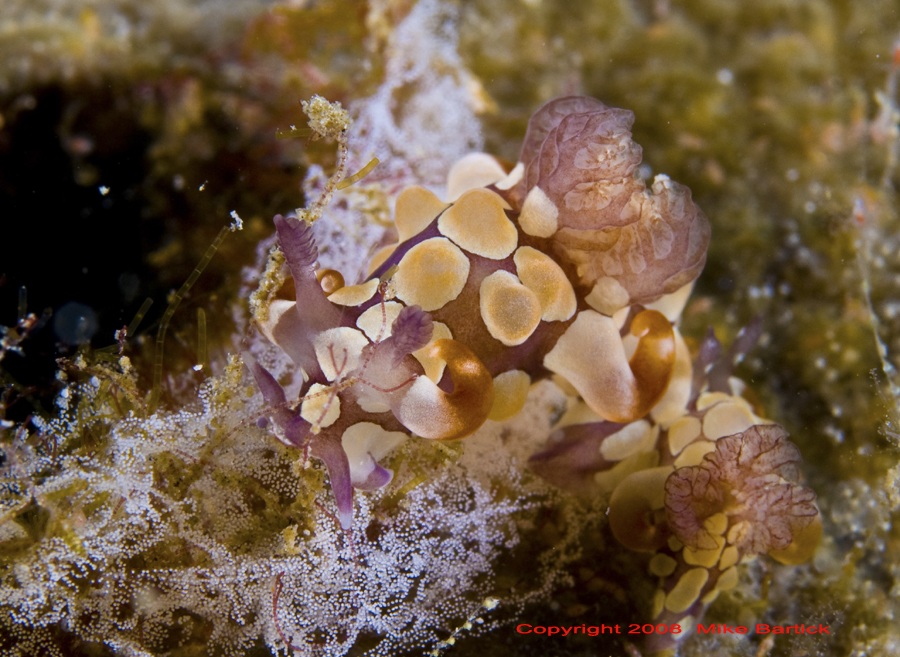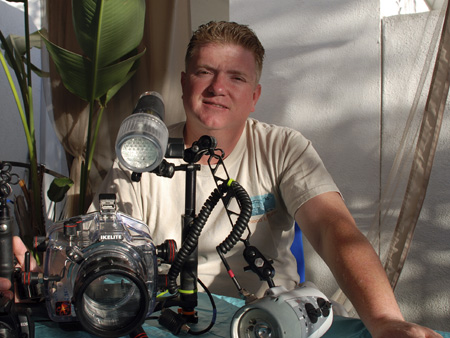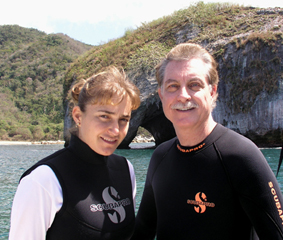 |
Trapania scurra
with egg massPhoto courtesy of Mike Bartick
Lembeh Straits, Indonesia
Picture taken with a Nikon D300, Sea and Sea housing, Dual Ys 110 strobes-60 mm macro lense
Trapania scurra, Gosliner & Fahey, 2008
This species is one of 16 new Trapania’s described by Terry Gosliner and Shireen Fahey in their recent monograph on the Goniodorididea.
Terry and Shireen gave it the trivial name – scurra – which is Latin for “jester” because of its bright colors reminiscent of a clown or a court jester. These colors easily distinguish the species from other members of the genus. The blue pigment on the head and tail are specific to this critter alone, and while other species have large white spots on the body, T. scurra’s are neatly surrounded by translucent lavender.
Little is known about the biology of this species. However, photo submitted to the Sea Slug Forum shows an animal near a colony of Kamtozoons or Entoprocts, the common food of Trapania’s. Mike’s photo above does provide us with some new information. Note the egg ribbon that larger specimen is crawling on. This disorganized coil is also typical of Trapania . To date it has only been reported from the Philippines, Indonesia and Malaysia
Reference: Gosliner, T.M. & Fahey, S.H. (2008) Systematics of Trapania (Mollusca: Nudibranchia: Goniodorididae) with descriptions of 16 new species Systematics and Biodiversity, 6 (1): 53-98
Gig Harbor
Jun, 2008
Mick Bartick after dive on oil rigs
 |
Mike Bartick is an avid and experienced scuba diver and Marine Wildlife Photographer residing in southern California. Mike admits that while he is a world traveling diver, the northern Channel Islands are amongst his favorite dive spots he has ever experienced. I have always been the fish in our family, loving the ocean and lakes; to swim and be free, floating in a liquid world. Gliding through the kelp forests, experiencing and discovering wild animals in the universe below, sharing through photography, is a dream come true. My love of photography comes from my father. As long as I can remember he always had his camera ready in hand. Given to me by my parents when I was in the eight grade, my first camera was a brownie box camera. |
Mike started shooting underwater with a friend's Minolta 110 at around fifteen years of age. While it was a film camera, there were a lot of "learning curve" shots and he started shooting less and less. When the digital camera age hit, he decided to start shooting more because of the new dynamics it brought to underwater photography.
Nothing about shooting in a liquid medium is easy. There is surge, ever changing light conditions and bursts of bubbles which scare fish off easily. Finding your subject is often times very difficult and once located, sometimes impossible to work with. Great macro shots require a perfect balance of light and skill. The lense is within inches of the subject. Generally higher F-stops and longer exposures make this type of photography difficult underwater. Lighting is extremely important. Overexposure kills, underexposure is just as bad. Perfectly lit subjects will glow with hand painted clarity and detail. The deeper you go, the less color you will have, and an experienced underwater photographer will always instinctively know what he is looking at and how to light it.
Marine Wildlife Photography
www.saltwaterphoto.com
Send Mike email at Mike@saltwaterphoto.com
March 2005

Ali Hermosillo and Dave Behrens
Author:
Pacific Coast Nudibranchs
Send Dave mail at dave@seachallengers.com
|
